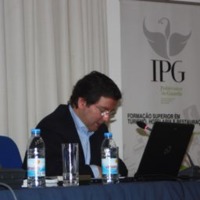
Paulo Duarte
Paulo Duarte (http://orcid.org/0000-0001-8449-5474) holds a PhD in Management and is Associate Professor with habilitation at the Faculty of Human and Social Sciences, Universidade da Beira Interior, Estrada do Sineiro - Edifício Ernesto Cruz, 6200-209 Covilhã (Portugal), Tel.: 351 275 319 828, pduarte@ubi.pt. He heads the MSc in Marketing and is Vice-Coordinator for marketing and Human Resources at NECE - Research Centre in Business Sciences. His research interests include consumer behaviour, the intersection between psychology and marketing, namely consumer and buying behaviour, sustainable consumer behaviour, satisfaction, and branding across sectors and industries, particularly in tourism, fashion, healthcare, higher education and electronic markets, both offline and online.
Phone: +351275319648
Address: Business and Economis Department
Estrada do Sineiro - Edif. Ernesto Cruz
Phone: +351275319648
Address: Business and Economis Department
Estrada do Sineiro - Edif. Ernesto Cruz
less
Related Authors
António Melo
Instituto Politécnico da Guarda
Saurabh Kumar Dixit
NORTH EASTERN HILL UNIVERSITY,SHILLONG
Chris Hattingh
Cape peninsula University of technology
Prof. Hossein Olya
The University of Sheffield
Hulisi Binbasioglu
Malatya Turgut Özal University
Gürkan Çalışkan
Kastamonu University
InterestsView All (25)










Uploads
Papers by Paulo Duarte
Purpose – This paper aims to discuss the estimation of PLS models with second-order formative constructs as existing research has mainly focused on second-order constructs with a reflective measurement.
Design/methodology/approach – Using a model grounded on Roger’s innovation diffusion theory applied to online travel shopping, an empirical application is used to assess and compare the different
approaches used to estimate a formative second-order construct. The proposed model examines the innovations characteristics that have an impact on intentions to purchase travel online, using data from a convenience sample of 1,732 responses.
Findings – The findings show that all approaches produce similar results regarding the path coefficients, the predictive relevance of the model and the explained variance. The main differences between the approaches are related to the weights of the first-order constructs on the second-order construct and the significance of those weights. Several recommendations are made for researchers on
which approach to use.
Originality/value – Since most research has focused on second-order constructs with a reflective measurement and there is limited research with formative second-order constructs, this paper provides a comparison of the different approaches typically used to estimate a formative second-order construct and present useful guidelines for researchers to decide the method to analyse a model with second-order constructs and how to assess formative second-order constructs.
The purpose of this study is to apply Mowen's (2000) Meta-theoretical Model of Motivation and Personality (3M) and its hierarchy of traits to deeper understand consumer behaviour toward online purchase of mass customised apparel products.
Design/methodology/approach
For the current study, the Meta-theoretical Model of Motivation and Personality (3M) and the hierarchy of traits proposed by Mowen (2000) was adapted to the used in the context of online purchase of mass customised apparel products. Appropriate and significant constructs and relationships were identified in the four levels of the hierarchy of needs, specifically: one trait in the first level (surface traits), five specific traits in the second level (situational traits), three broader traits in the third level (compound traits), and finally, eight traits in the fourth level (elemental traits).
Findings
This research allowed the identification of pertinent personality traits in the context of online purchase of mass customised apparel products and the comprehension of the relationships among these constructs using a hierarchical framework.
Originality/value
The originality and value of the current approach is the use of a hierarchical structure of traits to understand the relationship among personality traits in the mass customisation field which, to the best of our knowledge no study has proposed. Theoretical and methodological contributions to the field derive from the current proposal.
Full-text available at: http://rdcu.be/oY8G
Purpose – This paper aims to discuss the estimation of PLS models with second-order formative constructs as existing research has mainly focused on second-order constructs with a reflective measurement.
Design/methodology/approach – Using a model grounded on Roger’s innovation diffusion theory applied to online travel shopping, an empirical application is used to assess and compare the different
approaches used to estimate a formative second-order construct. The proposed model examines the innovations characteristics that have an impact on intentions to purchase travel online, using data from a convenience sample of 1,732 responses.
Findings – The findings show that all approaches produce similar results regarding the path coefficients, the predictive relevance of the model and the explained variance. The main differences between the approaches are related to the weights of the first-order constructs on the second-order construct and the significance of those weights. Several recommendations are made for researchers on
which approach to use.
Originality/value – Since most research has focused on second-order constructs with a reflective measurement and there is limited research with formative second-order constructs, this paper provides a comparison of the different approaches typically used to estimate a formative second-order construct and present useful guidelines for researchers to decide the method to analyse a model with second-order constructs and how to assess formative second-order constructs.
The purpose of this study is to apply Mowen's (2000) Meta-theoretical Model of Motivation and Personality (3M) and its hierarchy of traits to deeper understand consumer behaviour toward online purchase of mass customised apparel products.
Design/methodology/approach
For the current study, the Meta-theoretical Model of Motivation and Personality (3M) and the hierarchy of traits proposed by Mowen (2000) was adapted to the used in the context of online purchase of mass customised apparel products. Appropriate and significant constructs and relationships were identified in the four levels of the hierarchy of needs, specifically: one trait in the first level (surface traits), five specific traits in the second level (situational traits), three broader traits in the third level (compound traits), and finally, eight traits in the fourth level (elemental traits).
Findings
This research allowed the identification of pertinent personality traits in the context of online purchase of mass customised apparel products and the comprehension of the relationships among these constructs using a hierarchical framework.
Originality/value
The originality and value of the current approach is the use of a hierarchical structure of traits to understand the relationship among personality traits in the mass customisation field which, to the best of our knowledge no study has proposed. Theoretical and methodological contributions to the field derive from the current proposal.
Full-text available at: http://rdcu.be/oY8G
big asset for companies owning them. Owing to the very close relationship between
brands and consumers, and the specific nature of branded products as an element of
consumer life style, the branded goods industry needs to extend its knowledge of
the process of brand preference formation in order to enhance brand equity.
This chapter show how Partial Least Squares (PLS) modeling can be used to suc-
cessfully test complex models where other approaches would fail due to the high
number of relationships, constructs and indicators. Here, PLS modeling is applied
to brand preference formation regarding mobile phones.
With a wider set of explanatory factors than prior studies, this one explores the
factors that contribute to the formation of brand preference using a PLS model
to understand the relationship between those and consumer preference for mobile
phone brands.
Despite the exploratory nature of the study, the results reveal that brand identity,
personality and image, together with self-image congruence have the highest impact
on brand preference. Some other factors linked to the consumer and the situation
also affect preference, but to a lesser degree.
considered to be a major category in the online market. Despite the significant bulk of research in this domain,
there are still issues barely explored related to consumer physical and psychological online interaction with
apparel products, specifically associated with an online mass customization strategy, co-design and made-to-
measure options.
Some models have been applied to explain personality constructs relevant to online consumer behavior,
although to the best of our knowledge no study has employed a hierarchical structure for understanding the
relationships among these personality constructs in the mass customization field. Thus, this study proposes
the use of MOWEN (2000) 3M Model of Motivation and Personality and its four levels hierarchy of traits, to
explain how Desire for Unique Products, Need for touch, Need for simplicity, Need for Reality and Fashion
involvement, influences Intention to purchase online mass customized apparel products.